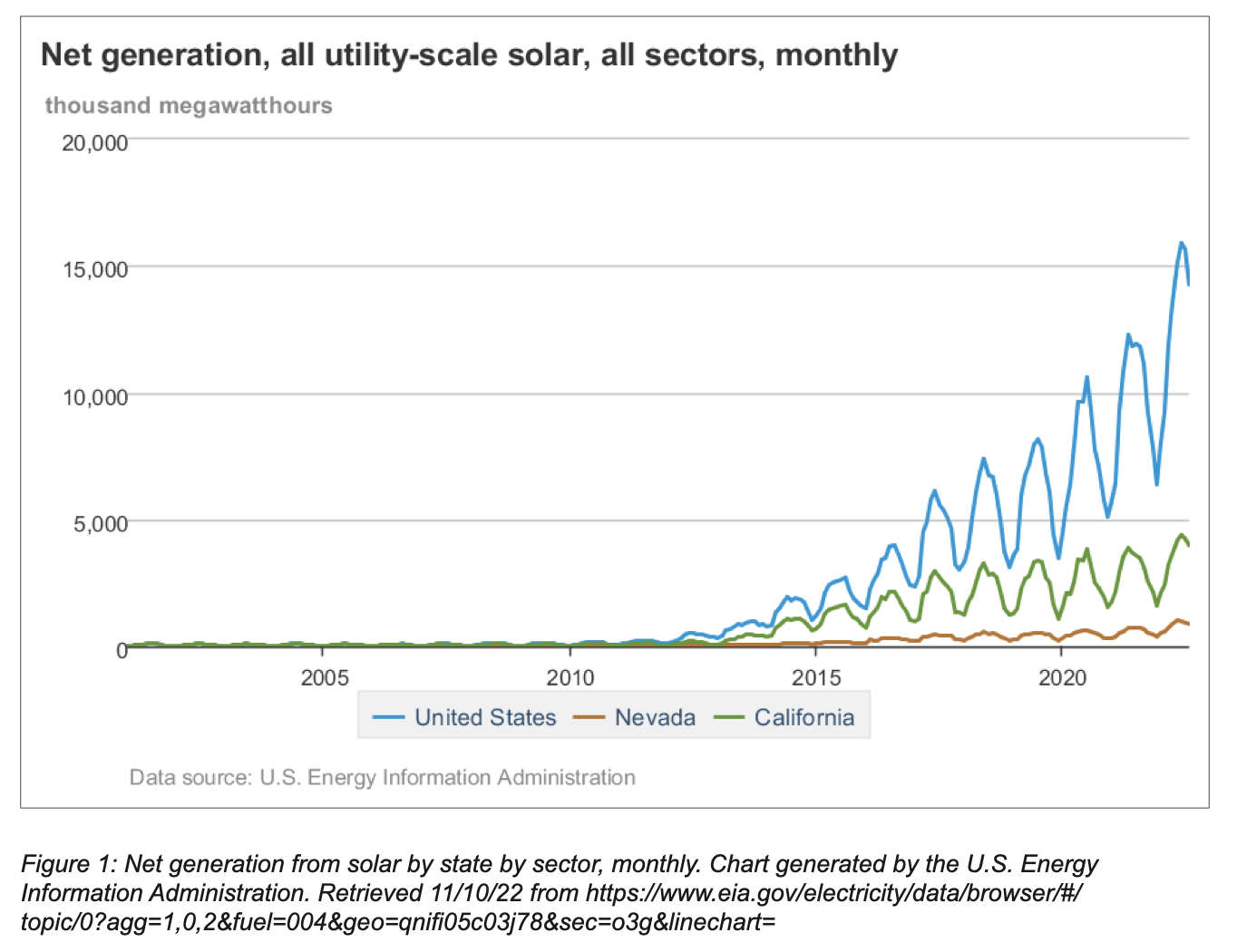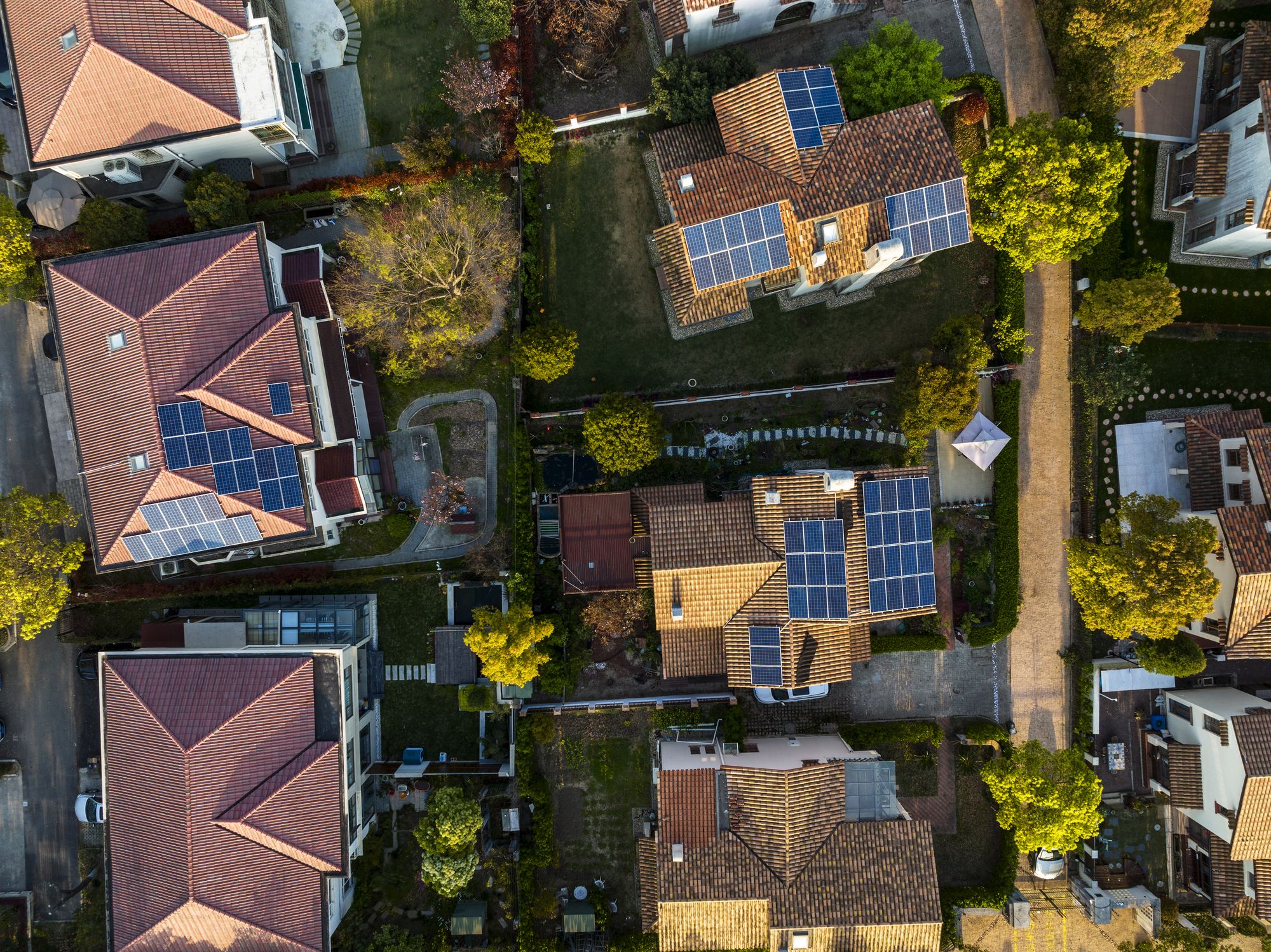“Like other renewable technologies, solar benefits from government subsidies and state mandates. Such subsidies reduce the costs directly attributable to solar power generation relative to traditional sources of electricity because taxpayers foot the bill.”
Quick Bullets
- Solar energy is generated when sunlight strikes photovoltaic panels, generating electricity.
- Solar energy made up 5 percent of total electricity generation in the United States at its early summertime peak in 2022.[1]
- In 2019, the average wholesale electricity price of solar was on average $36 per megawatt-hour.[2]
- Solar does not work at night, performs poorly in cloudy conditions and during winter months, and struggles in high temperatures.
Introduction
Solar energy is electricity or thermal energy generated by sunlight striking either photovoltaic (PV) panels for electricity generation,[3] or Concentrating SolarThermal Power (CSP), which concentrates solar radiation for use as either electricity or thermal (heat) energy.[4]
CSP plants are most often used for larger scale electricity generation. Utility-scale CSP plants use large ground-mounted mirrors, which reflect and concentrate solar radiation onto a receiver tower.
PV technology systems use individual PV “cells” that are linked together into panels or modules.[5] This type of solar power generation makes up most of the utility-scale electricity generation from solar in the United States.[6]
Solar Use in the United States and World
The U.S. Energy Information Administration (EIA) reports that U.S. utility-scale solar energy peaked at 15,917 thousand-megawatt-hours in June 2022, as seen in Figure 1. [7] Installed solar capacity has increased over time, but even at its summertime peak, it only comprises about 5 percent of total electricity generation in the United States.
Installed solar capacity worldwide was approximately 843 gigawatts in 2021.[8] However, because in-use global solar generation technologies average a capacity factor of 14 percent, the amount of electricity generated by all solar sources combined is a fraction of the installed capacity.[9]
The discrepancy between installed capacity and power generation is in part due to the intermittent nature of solar power as a source of energy. Solar electricity generation only works when sunlight is present. Therefore, on cloudy days and at night, power generation decreases or is absent entirely. Also—as Figure 1 demonstrates—when the days are shorter and often cloudier in winter, solar power production declines. Moreover, extremely high temperatures can also reduce the power output of solar cells by up to 25 percent.[10] Overheating the PV cells leads to a voltage drop, which despite increased current, will cause power output to decline.
Unless damaged, an average PV solar panel will last about 25 years, at which point the efficiency of PV panels drops.[11] Some studies estimate the rate of degradation is approximately 0.8 percent annually. Solar panel power output is also reduced by dust and dirt on the glass.[12] To ensure the highest possible power generation from any solar array, it needs to be regularly cleaned. Maintaining clean solar modules can be difficult when they are located on rooftops or in remote or arid locations, with significant amounts of blowing sand and dust but limited access to fresh water.

Costs and Subsidies
Solar power has a low Levelized Cost of Energy (LCOE) compared to traditional sources of electricity generation like coal, natural gas, and nuclear.[13] The LCOE value, however, fails to reflect the full costs of solar power. For instance, other power generating sources must be kept on standby or idling to rapidly cycle up when solar power generation fluctuates, or is limited during times when sunlight is not present. And because solar panels do not generate electricity at night, necessitating replacement supplies, the true cost of solar is higher than LCOE estimates—which only account for the capital costs of building or fueling individual facilities.[14] As a result, the EIA reports that solar photovoltaic electricity prices are substantially higher than other power sources.[15]
Like other renewable technologies, solar benefits from government subsidies and state mandates.
Updated in the Inflation Reduction Act of 2022, the Renewable Electricity Production Tax Credit grants a per-kilowatt hour credit for any electricity generated by approved renewables.[16] Electricity from solar gets up to 2.5 cents per kilowatt hour for the first 10 years of service,[17] or the investment tax credit of 30 percent,[18] depending on the size of the installation. Such subsidies reduce the costs directly attributable to solar power generation relative to traditional sources of electricity because taxpayers foot the bill.
In addition, individual states’ renewable portfolio standards mandating increased amounts of wind and/ or solar electricity be delivered within the state have also contributed to the growth of solar power despite its high cost and lack of reliability. [19]
Endnotes
[1] U.S. Energy Information Administration, “Electricity Data Browser: Net Generation, all utility scale solar, all sectors, monthly,” Retrieved November 21, 2022, from
https://www.eia.gov/electricity/data/browser/#/topic/0?agg=1,0,2&fuel=004&geo=qnifi05c03j78&sec=o3g&linechart=ELEC.GEN.SUN-US-99.M~ELEC.GEN.SUN-NV-99.M~ELEC.GEN.SUNCA-99.M~~~~~~~~~~~~~~~&columnchart=ELEC.GEN.SUN-US-99.M~ELEC.GEN.SUN-NV-99.M~ELEC.GEN.SUN-CA-99.M&map=ELEC.GEN.SUN-US-99.M&freq=M&start=
[2] Eric Harrison, “Solar photovoltaic generators receive higher electricity prices than other technologies,” U.S. Energy Information Administration, October 9, 2020,
https://www.eia.gov/todayinenergy/detail.php?id=45436
[3] U.S. Department of Energy: Office of Energy Efficiency and Renewable Energy, “How does solar work?” Retrieved November 21, 2022, from
https://www.energy.gov/eere/solar/how-does-solar-work
[4] U.S. Department of Energy: Office of Energy Efficiency and Renewable Energy, “Concentrating solar-thermal power basics,” Retrieved November 21, 2022, from
https://www.energy.gov/eere/solar/concentrating-solar-thermal-power-basics
[5] U.S. Department of Energy: Office of Energy Efficiency and Renewable Energy, “PV Cells 101: A Primer on the Solar Photovoltaic Cell,” Retrieved November 21, 2022, from
https://www.energy.gov/eere/solar/articles/pv-cells-101-primersolar-photovoltaic-cell
[6] U.S. Energy Information Administration (EIA), “Electricity Data Browser: Net Generation, all utility scale solar, all sectors, monthly.”
[7] Ibid.
[8] Our World in Data, “Installed Solar Energy Capacity,” Retrieved November 21, 2022, from https://ourworldindata.org/grapher/installed-solar-pv-capacity
[9] Our World in Data, “Solar energy generation vs. capacity, 2021,” Retrieved November 21, 2022, from
https://ourworldindata.org/grapher/solar-pv-energy-consumption-vs-solar-pv-capacity?tab=table
[10] SolarQuery.com, “Do Solar Panels Get Hot? Impact of Temperature on Solar Panels,” October 27, 2021,
https://solarquery.com/do-solar-panels-get-hot-impact-of-temperature-on-solar-panels/
[11] Andrew Sendy, “How long do solar panels actually last?” SolarReviews.com, updated January 14, 2022,
https://www.solarreviews.com/blog/how-long-do-solar-panels-last
[12] Jacqueline Medina, “How to: Clean Solar Panels,” BobVila.com, updated April 7, 2022,
https://www.bobvila.com/articles/how-to-clean-solar-panels/
[13] U.S. Energy Information Administration, “Levelized Costs of New Generation Resources in the Annual Energy Outlook 2022,” Retrieved November 21, 2022, from
https://www.eia.gov/outlooks/aeo/pdf/electricity_generation.pdf
[14] David Wojick, “Reliable wind and solar are not cheap,” CFACT, August 11, 2022,
https://www.cfact.org/2022/08/11/reliable-wind-and-solar-are-not-cheap/
[15] Eric Harrison, “Solar photovoltaic generators receive higher electricity prices than other technologies.”
[16] NC Clean Energy Technology Center, “Renewable Electricity Production Tax Credit,” DSIRE, September 9, 2022,
https://programs.dsireusa.org/system/program/detail/734/renewable-electricity-production-tax-credit-ptc
[17] Ibid.
[18] U.S. Department of Energy: Solar Energy Technologies Office, “Federal Solar Tax Credits for Businesses,” Retrieved November 21, 2022, from
https://www.energy.gov/eere/solar/federal-solar-tax-credits-businesses
[19] U.S. Energy Information Administration, “Renewable energy explained: Portfolio standards,” Retrieved November 21, 2022, from
https://www.eia.gov/energyexplained/renewable-sources/portfolio-standards.php
“Like other renewable technologies, solar benefits from government subsidies and state mandates. Such subsidies reduce the costs directly attributable to solar power generation relative to traditional sources of electricity because taxpayers foot the bill.”
Quick Bullets
- Solar energy is generated when sunlight strikes photovoltaic panels, generating electricity.
- Solar energy made up 5 percent of total electricity generation in the United States at its early summertime peak in 2022.[1]
- In 2019, the average wholesale electricity price of solar was on average $36 per megawatt-hour.[2]
- Solar does not work at night, performs poorly in cloudy conditions and during winter months, and struggles in high temperatures.
Introduction
Solar energy is electricity or thermal energy generated by sunlight striking either photovoltaic (PV) panels for electricity generation,[3] or Concentrating SolarThermal Power (CSP), which concentrates solar radiation for use as either electricity or thermal (heat) energy.[4]
CSP plants are most often used for larger scale electricity generation. Utility-scale CSP plants use large ground-mounted mirrors, which reflect and concentrate solar radiation onto a receiver tower.
PV technology systems use individual PV “cells” that are linked together into panels or modules.[5] This type of solar power generation makes up most of the utility-scale electricity generation from solar in the United States.[6]
Solar Use in the United States and World
The U.S. Energy Information Administration (EIA) reports that U.S. utility-scale solar energy peaked at 15,917 thousand-megawatt-hours in June 2022, as seen in Figure 1. [7] Installed solar capacity has increased over time, but even at its summertime peak, it only comprises about 5 percent of total electricity generation in the United States.
Installed solar capacity worldwide was approximately 843 gigawatts in 2021.[8] However, because in-use global solar generation technologies average a capacity factor of 14 percent, the amount of electricity generated by all solar sources combined is a fraction of the installed capacity.[9]
The discrepancy between installed capacity and power generation is in part due to the intermittent nature of solar power as a source of energy. Solar electricity generation only works when sunlight is present. Therefore, on cloudy days and at night, power generation decreases or is absent entirely. Also—as Figure 1 demonstrates—when the days are shorter and often cloudier in winter, solar power production declines. Moreover, extremely high temperatures can also reduce the power output of solar cells by up to 25 percent.[10] Overheating the PV cells leads to a voltage drop, which despite increased current, will cause power output to decline.
Unless damaged, an average PV solar panel will last about 25 years, at which point the efficiency of PV panels drops.[11] Some studies estimate the rate of degradation is approximately 0.8 percent annually. Solar panel power output is also reduced by dust and dirt on the glass.[12] To ensure the highest possible power generation from any solar array, it needs to be regularly cleaned. Maintaining clean solar modules can be difficult when they are located on rooftops or in remote or arid locations, with significant amounts of blowing sand and dust but limited access to fresh water.

Costs and Subsidies
Solar power has a low Levelized Cost of Energy (LCOE) compared to traditional sources of electricity generation like coal, natural gas, and nuclear.[13] The LCOE value, however, fails to reflect the full costs of solar power. For instance, other power generating sources must be kept on standby or idling to rapidly cycle up when solar power generation fluctuates, or is limited during times when sunlight is not present. And because solar panels do not generate electricity at night, necessitating replacement supplies, the true cost of solar is higher than LCOE estimates—which only account for the capital costs of building or fueling individual facilities.[14] As a result, the EIA reports that solar photovoltaic electricity prices are substantially higher than other power sources.[15]
Like other renewable technologies, solar benefits from government subsidies and state mandates.
Updated in the Inflation Reduction Act of 2022, the Renewable Electricity Production Tax Credit grants a per-kilowatt hour credit for any electricity generated by approved renewables.[16] Electricity from solar gets up to 2.5 cents per kilowatt hour for the first 10 years of service,[17] or the investment tax credit of 30 percent,[18] depending on the size of the installation. Such subsidies reduce the costs directly attributable to solar power generation relative to traditional sources of electricity because taxpayers foot the bill.
In addition, individual states’ renewable portfolio standards mandating increased amounts of wind and/ or solar electricity be delivered within the state have also contributed to the growth of solar power despite its high cost and lack of reliability. [19]
Endnotes
[1] U.S. Energy Information Administration, “Electricity Data Browser: Net Generation, all utility scale solar, all sectors, monthly,” Retrieved November 21, 2022, from
https://www.eia.gov/electricity/data/browser/#/topic/0?agg=1,0,2&fuel=004&geo=qnifi05c03j78&sec=o3g&linechart=ELEC.GEN.SUN-US-99.M~ELEC.GEN.SUN-NV-99.M~ELEC.GEN.SUNCA-99.M~~~~~~~~~~~~~~~&columnchart=ELEC.GEN.SUN-US-99.M~ELEC.GEN.SUN-NV-99.M~ELEC.GEN.SUN-CA-99.M&map=ELEC.GEN.SUN-US-99.M&freq=M&start=
[2] Eric Harrison, “Solar photovoltaic generators receive higher electricity prices than other technologies,” U.S. Energy Information Administration, October 9, 2020,
https://www.eia.gov/todayinenergy/detail.php?id=45436
[3] U.S. Department of Energy: Office of Energy Efficiency and Renewable Energy, “How does solar work?” Retrieved November 21, 2022, from
https://www.energy.gov/eere/solar/how-does-solar-work
[4] U.S. Department of Energy: Office of Energy Efficiency and Renewable Energy, “Concentrating solar-thermal power basics,” Retrieved November 21, 2022, from
https://www.energy.gov/eere/solar/concentrating-solar-thermal-power-basics
[5] U.S. Department of Energy: Office of Energy Efficiency and Renewable Energy, “PV Cells 101: A Primer on the Solar Photovoltaic Cell,” Retrieved November 21, 2022, from
https://www.energy.gov/eere/solar/articles/pv-cells-101-primersolar-photovoltaic-cell
[6] U.S. Energy Information Administration (EIA), “Electricity Data Browser: Net Generation, all utility scale solar, all sectors, monthly.”
[7] Ibid.
[8] Our World in Data, “Installed Solar Energy Capacity,” Retrieved November 21, 2022, from https://ourworldindata.org/grapher/installed-solar-pv-capacity
[9] Our World in Data, “Solar energy generation vs. capacity, 2021,” Retrieved November 21, 2022, from
https://ourworldindata.org/grapher/solar-pv-energy-consumption-vs-solar-pv-capacity?tab=table
[10] SolarQuery.com, “Do Solar Panels Get Hot? Impact of Temperature on Solar Panels,” October 27, 2021,
https://solarquery.com/do-solar-panels-get-hot-impact-of-temperature-on-solar-panels/
[11] Andrew Sendy, “How long do solar panels actually last?” SolarReviews.com, updated January 14, 2022,
https://www.solarreviews.com/blog/how-long-do-solar-panels-last
[12] Jacqueline Medina, “How to: Clean Solar Panels,” BobVila.com, updated April 7, 2022,
https://www.bobvila.com/articles/how-to-clean-solar-panels/
[13] U.S. Energy Information Administration, “Levelized Costs of New Generation Resources in the Annual Energy Outlook 2022,” Retrieved November 21, 2022, from
https://www.eia.gov/outlooks/aeo/pdf/electricity_generation.pdf
[14] David Wojick, “Reliable wind and solar are not cheap,” CFACT, August 11, 2022,
https://www.cfact.org/2022/08/11/reliable-wind-and-solar-are-not-cheap/
[15] Eric Harrison, “Solar photovoltaic generators receive higher electricity prices than other technologies.”
[16] NC Clean Energy Technology Center, “Renewable Electricity Production Tax Credit,” DSIRE, September 9, 2022,
https://programs.dsireusa.org/system/program/detail/734/renewable-electricity-production-tax-credit-ptc
[17] Ibid.
[18] U.S. Department of Energy: Solar Energy Technologies Office, “Federal Solar Tax Credits for Businesses,” Retrieved November 21, 2022, from
https://www.energy.gov/eere/solar/federal-solar-tax-credits-businesses
[19] U.S. Energy Information Administration, “Renewable energy explained: Portfolio standards,” Retrieved November 21, 2022, from
https://www.eia.gov/energyexplained/renewable-sources/portfolio-standards.php


